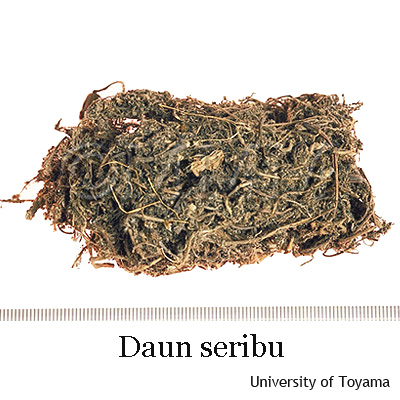Crude drug sample data base
※Click on the image to enlarge it.
Scientific information data base
| Crude drug name | Indonesian name, English name | Daun seribu, Yarrow | ||
|---|---|---|---|---|
| crude drug image |
| |||
| Original plant name | Achillea millefolium Linn. | |||
| Family name | Compositae | |||
| Used part | Leaves | |||
| Distribution area | It is cultivated in mountainous areas of some parts of Malaysia. It grows wild in mountainous areas in East Java and Central Java (Indonesia) in grassland and roadsides at 1500-1600 m altitude. It was also cultivated as ornamentals [201, 205]. | |||
| Description | Leaves alternate, clustered at the base of the stem and with smaller leaves upwards, highly dissected, up to 3-pinnatifid, lanceolate to linear in outline, up to 20 cm x 6 cm. The plant is a perennial herb, 20-50 cm tall, with aromatic odour and greyish-green colour from the numerous small hairs. Flowering heads in a flat-topped corymb, small, colour varied from white to pink, magenta and red. Fruit a compressed achene, oblong or obovate [205, 222]. | |||
| Drug effect | Bitter, neutralizing [231]. It has antiphlogistic, spasmolytic, stomachic, carminative, choleretic properties [205]. | |||
| Specific actions | Spasmolytic, stomachic, anti-inflammatory, haemostyptic/hemostyptic [201, 205]. | |||
| Frequency in use | Moderate. | |||
| Pharmacological effect | The anti-inflammatory and antispasmodic effects have been shown in a mouse-foot-pad oedema model and an isolated rabbit-ileum model [205]. Sesquiterpene lactones exhibit antimicrobial, cytotoxic and anti cancer activity [205]. Research on the in vitro antimicrobial and antioxidant activities of the essential oil and methanol extracts of Achillea millefolium subsp. millefolium Afan. Showed that the oil has antimicrobial activity against Streptococcus pneumoniae, Clostridium perfringens, Candida albicans, Mycobacterium smegmatis, Acinetobacter lwoffii and Candida krusei. The water-insoluble parts of the methanolic extracts exhibited slight or no activity. The research also confirmed their antioxidant property [PMID:12860311]. The crude extract of Achillea millefolium was studied and confirmed to have a hepatoprotective effect, which may be partly attributed to its observed calcium channel blocking activity [PMID:16619341]. The aqueous extract of the aerial parts of Achillea millefolium has antiulcer property and do not show any signs of relevant toxicity after chronic exposure [PMID:16647233]. In tea prepared from yarrow, the concentration of the flavonoids is high enough to exert a spasmolytic effect in the gut, which is caused mainly by blockade of the calcium inward current and by mediator-antagonistic effects [PMID:17009839]. | |||
| Medical system | Indonesian medicine (Jamu) | |||
| Traditional usage | Infusion and decoction of the leaves and flowers are used to treat gastrointestinal complaints and dysmenorrhea. It is also used as a spasmolytic, haemostyptic/hemostyptic (bleeding) and anti-depressant [201, 205]. | |||
| Formulation | 1) Dysmenorrhea: 10 grams of fresh aboveground parts of yarrow is boiled with 115 ml of water. Stand to cool and strain. Drink 100 ml of the decoction once a day for 3 days before menstruation [231]. 2) Stomach upset: 10 grams of fresh aboveground parts of yarrow and 2 tablespoon of arrowroot starch is boiled with 110 ml of water. Stand to cool and strain. Drink 100 ml of the decoction once a day for three days [231]. 3) Hypertension (high blood pressure): 8 grams of aboveground parts of A. millefolium, 4 grams of flowers of Hibiscus tiliaceus are boiled with 110 ml of water to make a decoction. Drink the decoction 100 ml once a day for 14 days [231]. | |||
| References | Reference book Tips! | [201] K. Heyne, Tumbuhan Berguna Indonesia, Vols. 1-4, 1987. Diedarkan Oleh Koperasi Karyawan Departemen Kehutanan, Jakarta, Indonesia. Vol. 3, p 1841. [205] de Pdua, L.S., Bunyapraphatsara, N. and Lemmens, R.H.M.J. (Editors), 1990. Plant Resources of South-East Asia No. 12 (1). Medicinal and poisonous plants 1. Backhuys Publishers, Leiden, Netherlands. pp 77-81. [222] P.T. Eisai Indonesia: Medical Herb Index in Indonesia (Second edition).1995. pp 218-219. [231] Soedibyo, Mooryati: Alam Sumber Kesehatan: Manfaat dan Kegunaan (Natural resources for health. Benefits and uses). Balai Pustaka. 1998. p 130. | ||
| Research paper | 1. Cavalcanti AM, Baggio CH, Freitas CS, Rieck L, de Sousa RS, Da Silva-Santos JE, Mesia-Vela S, Marques MC. Safety and antiulcer efficacy studies of Achillea millefolium L. after chronic treatment in Wistar rats. J Ethnopharmacol. 19;107(2):277-84 2006. (PMID: 16647233) 2. Candan F, Unlu M, Tepe B, Daferera D, Polissiou M, Sokmen A, Akpulat HA.Antioxidant and antimicrobial activity of the essential oil and methanol extracts of Achillea millefolium subsp. millefolium Afan. (Asteraceae). J Ethnopharmacol. 87(2-3):215-20, 2003. (PMID: 12860311) 3. Dmitrenko OD. Burn catastrophes (the problems of organizing the delivery of care to burn patients) Vestn Khir Im I I Grek. 146(4):143-6, 1991. (PMID: 1661934) 4. Morris SA, Wittner M, Weiss L, Hatcher VB, Tanowitz HB, Bilezikian JP, Gordon PB. Extracellular matrix derived from Trypanosoma cruzi infected endothelial cells directs phenotypic expression. J Cell Physiol. 145(2):340-6, 1990. (PMID: 1700983) | |||
| Last renewal date | 2024/03/06 | |||


